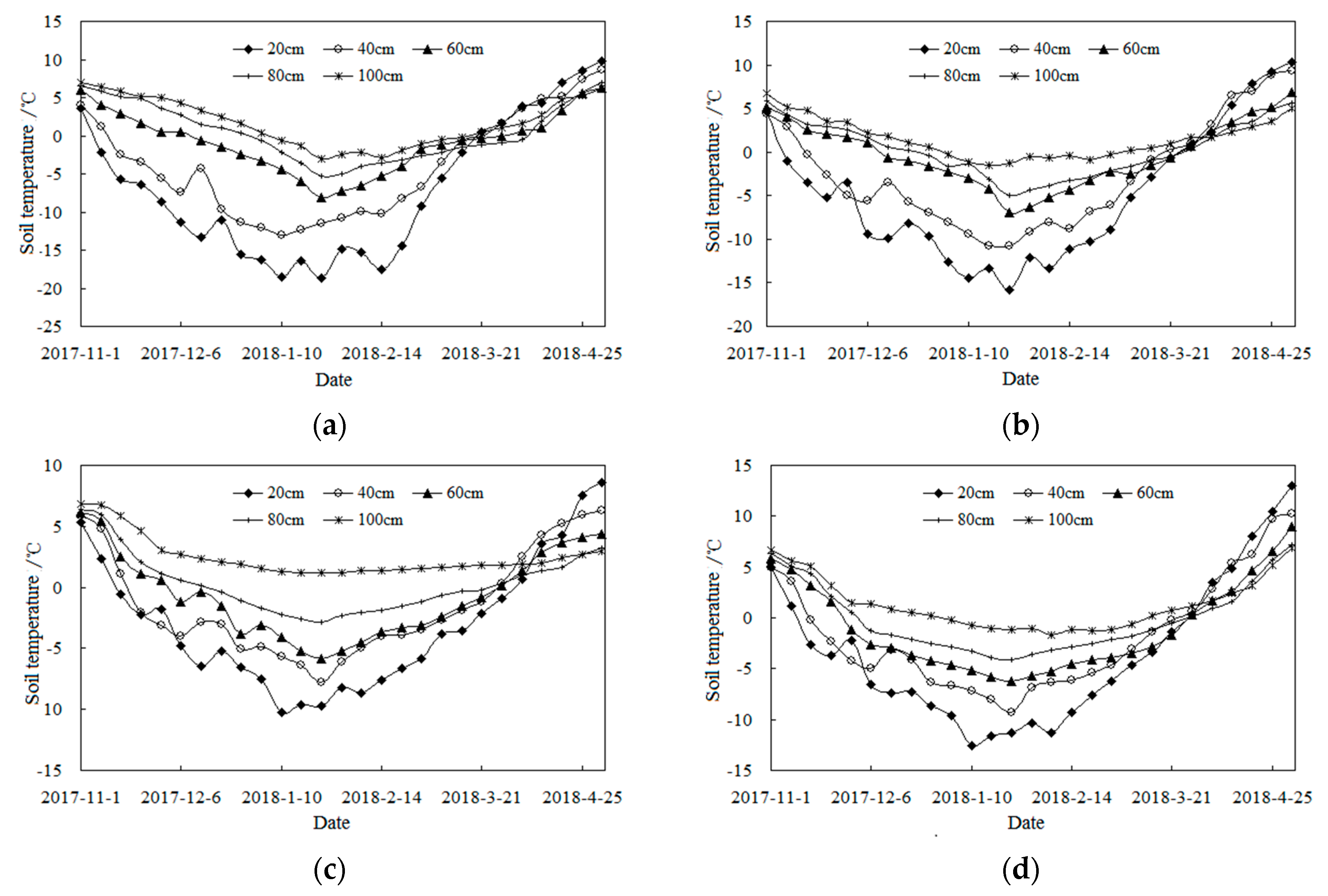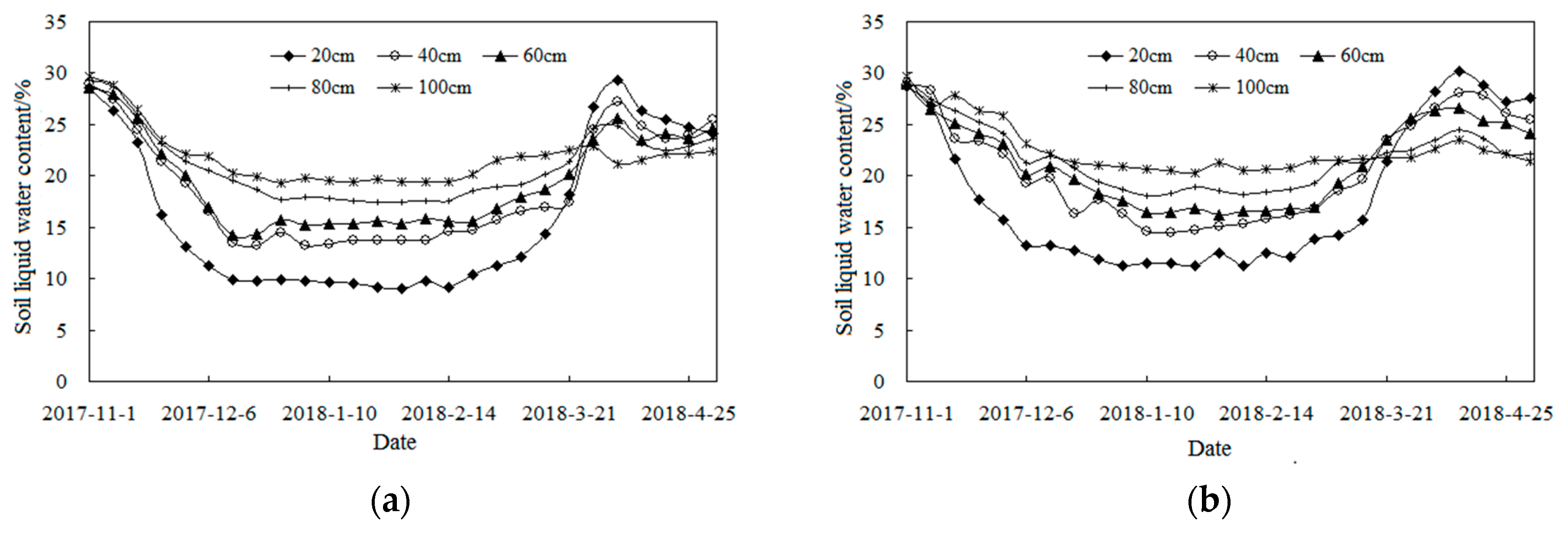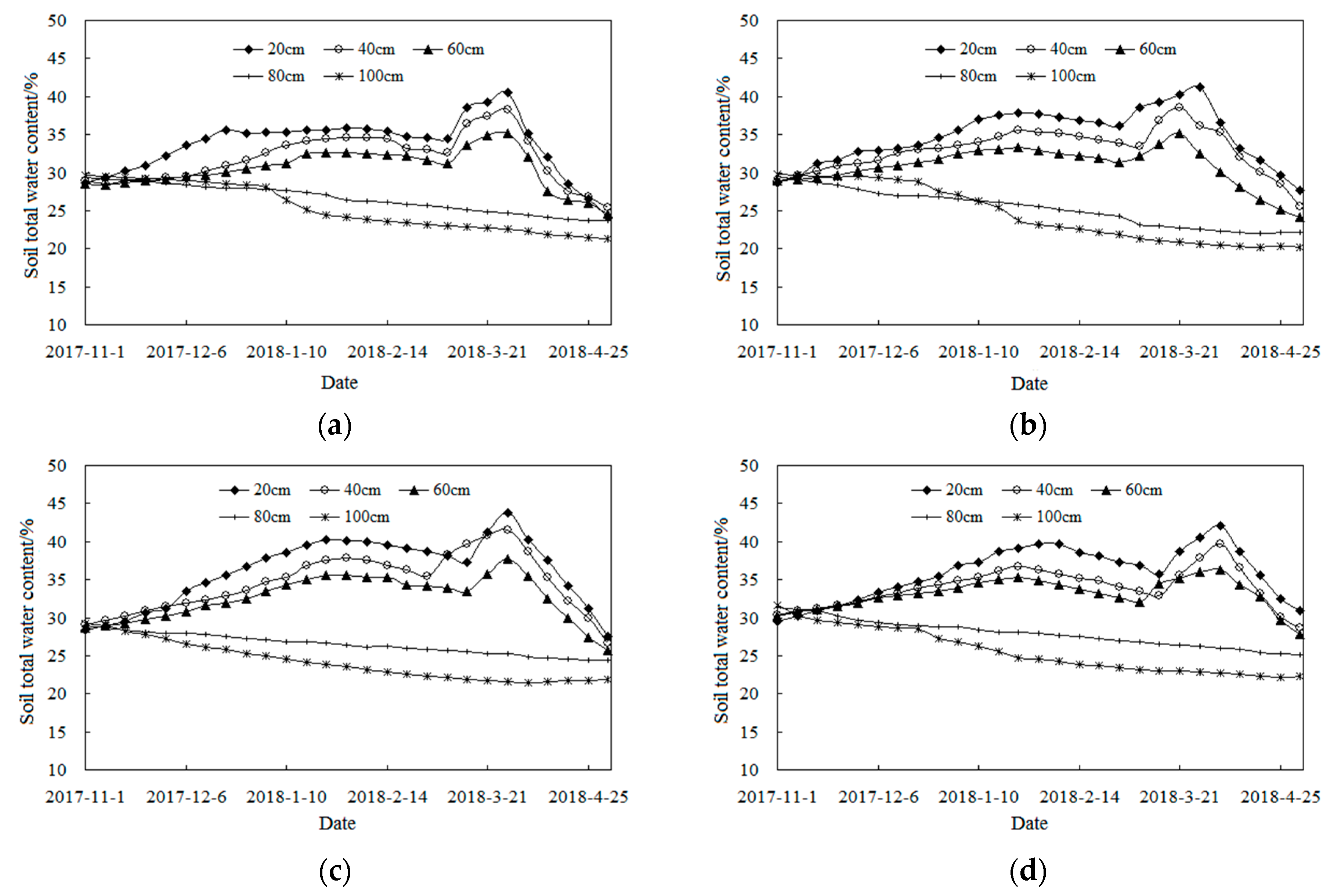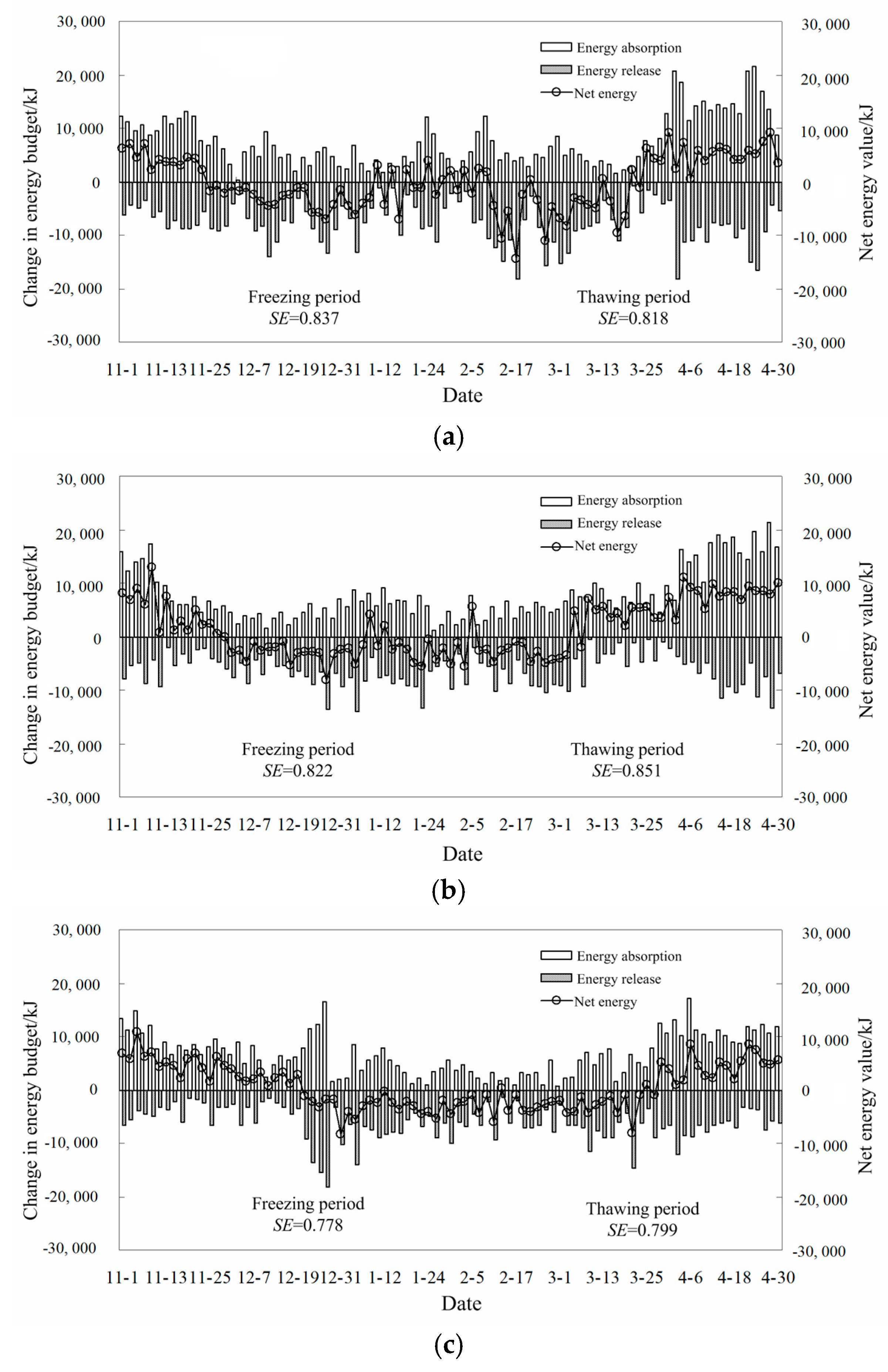Variability of Soil Water Heat and Energy Transfer Under Different Cover Conditions in a Seasonally Frozen Soil Area
Abstract
1. Introduction
2. Materials and Methods
2.1. Study Area
2.2. Experimental Field Deployment
2.3. Theory
2.4. Data Processing
3. Results and Discussion
3.1. Variability of Soil Water Heat
- (1)
- The soil temperature decreased first and then increased. First, during the freezing period, under the BL treatment, the variation amplitude of the soil temperature at a soil depth of 20 cm was 22.21 °C; With the increase of soil depth, the variation amplitude of the soil temperature decreased in order accordingly. Under the CS treatment, the variation amplitude of the soil temperature at a depth of 20 cm was 20.37 °C, which was less than that of the BL treatment. Under the JS and CJS treatments, the variation amplitudes of the soil temperature at a soil depth of 20 cm were 15.12 °C and 16.28 °C, respectively. During the thawing period, compared with the BL treatment, the temperatures in the CS, JS, and CJS treatments all had greatly increased amplitudes at a soil depth of 20 cm.
- (2)
- During the freezing period, the variation amplitudes of the soil liquid water content at a soil depth of 20 cm under the BL, CS, JS, and CJS treatments were 19.46, 17.47, 13.31, and 16.34%, respectively. During the thawing period, with the thawing of soil and the infiltration of snowmelt water, the liquid water content in the soil increased. The maximum value of the soil liquid water content under the BL treatment was 29.13%; the maximum values of the soil liquid water content under the CS, JS, and CJS treatments were all increased, and their average values had a decreasing order of CJS > CS > JS > BL.
- (3)
- During the freezing period, the variation amplitudes of the soil liquid water content at a soil depth of 20 cm under the BL, CS, JS, and CJS treatments were 6.95%, 9.24%, 11.82%, and 9.89%, respectively. During the thawing period, because of the snowmelt water infiltration, the variability of the soil total water content was similar to that of the soil liquid water content. The maximum value of the soil total water content under the BL treatment was 40.51%, while the maximum values of the total water content were all increased under the CS, JS, and CJS treatments, and the most significant increase occurred under the CJS treatment.
3.2. Balance Effect of the Soil Energy Budget
- (1)
- During the freezing period, the soil energy absorption gradually decreased, and the release gradually increased, while the net energy value exhibited a gradual decreasing trend. Under the BL treatment, the average net soil energy was −763 kJ, indicating an energy deficit. Under the CS treatment, the average soil net energy was −667 kJ; the regulation of biochar increased the soil energy absorption and thus decreased the energy deficit in the net soil energy. Under the JS and CJS treatments, the average net soil energies were further reduced, and the negative energy budget was gradually reduced. Under the BL treatment, the spectral entropy of a time series of the net soil energy was 0.837, which indicated strong fluctuations, and the energy exchange process between the soil and the environment was frequent. Under the CS, JS, and CJS treatments, the spectral entropies decreased differently, and their fluctuations followed the descending order of BL > CS > CJS > JS.
- (2)
- During the thawing period, as the ambient temperature and the atmospheric radiation increased, the net soil energy showed a gradually increasing trend. Specifically, the average net soil energies were 771, 951, 703, and 837 kJ under the BL, CS, JS, and CJS treatments, respectively, indicating that, during the thawing period, the CS treatment exacerbated the fluctuation of the net soil energy, while the JS treatment had the opposite trend.
- (3)
- During the freezing period, under the BL treatment, the spectral entropy of the time series of the net soil energy was 0.811 at a soil depth of 20 cm; as the soil depth increased, the spectral entropy gradually decreased, and the energy exchange between the soil and the external environment was weakened. Likewise, the other three treatments also showed similar patterns. Specifically, the BL treatment had the most significant fluctuations, and the JS treatment had the weakest fluctuations. During the thawing period, the spectral entropies of the net energy in the vertical profile under the CS and CJS treatments had an overall greater variation than that under the BL treatment, while the JS treatment had a lower spectral entropy of the net energy than the BL treatment.
3.3. Response Function of Soil Energy Transfer
4. Discussion
4.1. Effect of Biochar and Straw on Soil Water and Heat Variation
4.2. Effects of Biochar and Straw on Soil Energy Budget
5. Conclusions
Author Contributions
Funding
Acknowledgments
Conflicts of Interest
References
- Hou, R.J.; Li, T.X.; Fu, Q.; Liu, D.; Cui, S.; Zhou, Z.Q.; Yan, P.R.; Yan, J.W. Effect of snow-straw collocation on the complexity of soil water and heat variation in the Songnen Plain, China. Catena 2019, 172, 190–202. [Google Scholar] [CrossRef]
- Li, R.; Zhao, L.; Wu, T.H.; Ding, Y.J.; Xiao, Y.; Hu, G.J.; Zou, D.F.; Li, W.P.; Yu, W.J.; Jiao, Y.L.; et al. The impact of surface energy exchange on the thawing process of active layer over the northern Qinghai-Xizang Plateau, China. Environ. Earth Sci. 2014, 72, 2091–2099. [Google Scholar] [CrossRef]
- Brown, D.R.N.; Jorgenson, M.T.; Douglas, T.A.; Romanovsky, V.E.; Kielland, K.; Hiemstra, C.; Euskirchen, E.S.; Ruess, R.W. Interactive effects of wildfire and climate on permafrost degradation in Alaskan lowland forests. J. Geophys. Res. Biogeosci. 2015, 120, 1619–1637. [Google Scholar] [CrossRef]
- Fu, Q.; Zhao, H.; Li, T.X.; Hou, R.J.; Liu, D.; Ji, Y.; Zhou, Z.Q.; Yang, L.Y. Effects of biochar addition on soil hydraulic properties before and after freezing-thawing. Catena 2019, 176, 112–124. [Google Scholar] [CrossRef]
- Roxy, M.S.; Sumithranand, V.B.; Renuka, G. Soil heat flux and day time surface energy balance closure at astronomical observatory, Thiruvananthapuram, south Kerala. J. Earth Sys. Sci. 2014, 123, 741–750. [Google Scholar] [CrossRef]
- Maurer, G.E.; Bowling, D.R. Seasonal snowpack characteristics influence soil temperature and water content at multiple scales in interior western US mountain ecosystem. Water Resour. Res. 2014, 50, 5216–5234. [Google Scholar] [CrossRef]
- Fu, Q.; Hou, R.J.; Li, T.X.; Yan, P.R.; Ma, Z.A. The critical depth of freeze-thaw soil under different types of snow cover. Water 2017, 9, 370. [Google Scholar]
- Zhang, X.; Sun, S.F. The impact of soil freezing/thawing processes on water and energy balances. Adv. Atmos. Sci. 2011, 28, 169–177. [Google Scholar] [CrossRef]
- Fu, Q.; Hou, R.J.; Li, T.X.; Wang, M.; Yan, J.W. The functions of soil water and heat transfer to the environment and associated response mechanisms under different snow cover conditions. Geoderma 2018, 325, 9–17. [Google Scholar] [CrossRef]
- Flint, A.L.; Flint, L.E.; Dettinger, M.D. Modeling soil moisture processes and recharge under a melting snowpack. Vadose Zone J. 2008, 7, 350–357. [Google Scholar] [CrossRef]
- Yang, K.; Wang, C.H. Water storage effect of soil freeze-thaw process and its impacts on soil hydro-thermal regime variations. Agric. For. Meteorol. 2019, 265, 280–294. [Google Scholar] [CrossRef]
- Zhang, Y.Y.; Zhao, W.Z. Effects of variability in land surface characteristics on the summer radiation budget across desert-oasis region in Northwestern China. Theor. Appl. Climatol. 2015, 119, 771–780. [Google Scholar] [CrossRef]
- Tang, A.C.I.; Stoy, P.C.; Hirata, R.; Musin, K.K.; Aeries, E.B.; Wenceslaus, J.; Shimizu, M.; Melling, L. The exchange of water and energy between a tropical peat forest and the atmosphere: Seasonal trends and comparison against other tropical rainforests. Sci. Total Environ. 2019, 683, 166–174. [Google Scholar] [CrossRef] [PubMed]
- Hallsted, A.L.; Mathews, O.R. Soil moisture and winter wheat with suggestions on abandonment. Kans. Agr. Exp. Stn. Bull 1936, 273, 46. [Google Scholar]
- Nagare, R.M.; Schincariol, R.A.; Quinton, W.L.; Hayashi, M. Moving the Field into the Lab: Simulation of Water and Heat Transport in Subarctic Peat. Permafr. Periglac. Process. 2012, 23, 237–243. [Google Scholar] [CrossRef]
- Guglielmin, M.; Evans, C.J.E.; Cannone, N. Active layer thermal regime under different vegetation conditions in permafrost areas. A case study at Signy Island (Maritime Antarctica). Geoderma 2008, 144, 73–85. [Google Scholar] [CrossRef]
- Chen, J.F.; Xie, X.; Zheng, X.Q.; Xue, J.; Miao, C.Y.; Du, Q.; Xu, Y.X. Effect of Straw Mulch on Soil Evaporation during Freeze-Thaw Periods. Water 2019, 11, 1689. [Google Scholar] [CrossRef]
- Xu, H.N.; Spitler, J.D. The relative importance of moisture transfer, soil freezing and snow cover on ground temperature predictions. Renew. Energy 2014, 72, 1–11. [Google Scholar] [CrossRef]
- Yang, J.F.; Zheng, X.Q.; Sun, M. The Effect of Different Surface Mulchings on Soil Temperature During Seasonal Freezing-thawing Period. J. Taiyuan Univ. Technol. 2006, 37, 358–360. [Google Scholar]
- Tang, W.Z.; Wang, C.X.; Lan, M.J.; Fan, W.B. An experimental research on surface cover’s effects on the temperature of the soil plough layer in the freezing and thawing period of the northern Xinjiang area. China Rural Water Hydropower 2016, 8, 44–49. [Google Scholar]
- Jarraud, M. Guide to Meteorological Instruments and Methods of Observation, 7th ed.; World Meteorological Organisation: Geneva, Switzerland, 2008; pp. 29–30. [Google Scholar]
- Fu, Q.; Ma, Z.A.; Li, T.X.; Hou, R.J. Influence of Different Covers on Heat Spatial Distribution and Transfer Efficiency of Freezing-thawing Soil. Trans. Chin. Soc. Agric. Mach. 2018, 49, 292–298. [Google Scholar]
- Istomin, V.A.; Chuvilin, E.M.; Sergeeva, D.V.; Bukhanov, B.A.; Badetz, C.; Stanilovskaya, Y.V. Thermodynamics of freezing soil closed system saturated with gas and water. Cold Reg. Sci. Technol. 2020, 170, 102901. [Google Scholar] [CrossRef]
- Taylor, R.T.; Luthin, J.N. A model for coupled heat and moisture transfer during soil freezing. Can. Geotech. J. 1978, 15, 548–555. [Google Scholar] [CrossRef]
- Ma, T.; Tang, T.; Huang, X.M.; Wang, H. Numerical analysis on thermal regime of wide embankment in permafrost regions of Qinghai−Tibet Plateau. J. Cent. South Univ. 2017, 23, 3346–3355. [Google Scholar] [CrossRef]
- Miescke, K.J.; Liese, F. Statistical Decision Theory-Estimation, Testing, and Selection; Springer: New York, NY, USA, 2008; pp. 198–232. [Google Scholar]
- Kiusalaas, J. Numerical Methods in Engineering With MATLAB; Cambridge University Press: New York, NY, USA, 2005; pp. 26–27. [Google Scholar]
- Systat Software, Inc. Using SigmaStat Statistics in SigmaPlot; Systat Software, Inc.: Chicago, IL, USA, 2012; pp. 416–430. [Google Scholar]
- Stanek, J.; Koźmiński, W. Iterative algorithm of discrete Fourier transform for processing randomly sampled NMR data sets. J. Biomol. NMR 2010, 47, 65–77. [Google Scholar] [CrossRef] [PubMed]
- Gau, H.S.; Hsieh, C.Y.; Liu, C.W. Application of grey correlation method to evaluate potential groundwater recharge sites. Stoch. Environ. Res. Risk Assess. 2006, 20, 407–421. [Google Scholar] [CrossRef]
- Larsbo, M.; Holten, R.; Stenrod, M.; Eklo, O.M.; Jarvis, N. A Dual-Permeability Approach for Modeling Soil Water Flow and Heat Transport during Freezing and Thawing. Vadose Zone J. 2019, 18, 190012. [Google Scholar] [CrossRef]
- Hou, R.J.; Li, T.X.; Fu, Q.; Liu, D.; Li, M.; Zhou, Z.Q.; Li, L.Q.; Zhao, H.; Yu, P.F.; Yan, J.W. The effect on soil nitrogen mineralization resulting from biochar and straw regulation in seasonally frozen agricultural ecosystem. J. Clean. Prod. 2020, 255, 120302. [Google Scholar] [CrossRef]
- Shan, X.Q.; Zheng, X.Q. Impacts of Surface Covering on Soil Water Characteristics during Seasonal Freeze-thaw Period. Water Res. Power 2018, 36, 99–103. [Google Scholar]
- Li, Q.L.; Li, H.; Fu, Q.; Li, T.X.; Liu, D.; Hou, R.J.; Cui, S.; Ji, Y.; Cai, Y.P. Effects of different biochar application methods on soybean growth indicator variability in a seasonally frozen soil area. Catena 2020, 185, 104307. [Google Scholar] [CrossRef]
- Bao, W.M.; Bai, Y.R.; Zhao, Y.P.; Zhang, X.; Wang, Y.Q.; Zhong, Y.X. Effect of Biochar on Soil Water Infiltration and Water Holding Capacity in the Arid Regions of Middle Ningxia. Chin. J. Soil Sci. 2018, 49, 1326–1332. [Google Scholar]
- Wu, Y.; Xu, G.; Lv, Y.C.; Shao, H.B. Effects of biochar amendment on soil physical and chemical properties: Current status and knowledge gaps. Adv. Earth Sci. 2014, 29, 68–79. [Google Scholar]
- Kustas, W.P.; Daughtry, C.S.T. Estimation of the soil heat flux/net radiation ratio from spectral data. Agric. For. Meteorol. 1990, 49, 205–223. [Google Scholar] [CrossRef]
- Zhao, J.K.; Ren, T.S.; Zhang, Q.Z.; Du, Z.L.; Wang, Y.D. Effects of Biochar Amendment on Soil Thermal Properties in the North China Plain. Soil Sci. Soc. Am. J. 2016, 80, 1157–1166. [Google Scholar] [CrossRef]
- Singh, B.; Eberbach, P.L.; Humphreys, E.; Kukal, S.S. The effect of rice straw mulch on evapotranspiration, transpiration and soil evaporation of irrigated wheat in Punjab, India. Agric. Water Manag. 2011, 98, 1847–1855. [Google Scholar] [CrossRef]
- Zhao, J.H.; Zhang, Q.; Wang, S.; Liu, H.Y. Effect of Soil Heat Slow Transmission Process on Surface Energy Balance in Semi-Arid Area. Chin. J. Soil Sci. 2013, 44, 1321–1331. [Google Scholar]






| Soil Depth (cm) | BL | CS | JS | CJS | ||||
|---|---|---|---|---|---|---|---|---|
| Field Water Holding Capacity (%) | Soil Bulk Density (g/cm3) | Field Water Holding Capacity (%) | Soil Bulk Density (g/cm3) | Field Water Holding Capacity (%) | Soil Bulk Density (g/cm3) | Field Water Holding Capacity (%) | Soil Bulk Density (g/cm3) | |
| 20 | 31.22 | 1.34 | 33.15 | 1.33 | 31.85 | 1.36 | 32.98 | 1.39 |
| 40 | 30.64 | 1.36 | 32.15 | 1.35 | 30.21 | 1.37 | 33.14 | 1.36 |
| 60 | 31.21 | 1.32 | 33.90 | 1.32 | 30.11 | 1.39 | 32.56 | 1.34 |
| 80 | 30.97 | 1.37 | 31.87 | 1.31 | 30.41 | 1.34 | 31.09 | 1.39 |
| 100 | 28.95 | 1.36 | 30.53 | 1.28 | 29.35 | 1.41 | 32.79 | 1.41 |
| Soil Depth/cm | Freezing Period | Thawing Period | ||||||
|---|---|---|---|---|---|---|---|---|
| BL | CS | JS | CJS | BL | CS | JS | CJS | |
| 20 | 0.811 | 0.803 | 0.752 | 0.775 | 0.791 | 0.822 | 0.763 | 0.807 |
| 30 | 0.795 | 0.786 | 0.728 | 0.751 | 0.762 | 0.794 | 0.734 | 0.773 |
| 40 | 0.772 | 0.765 | 0.711 | 0.736 | 0.735 | 0.771 | 0.701 | 0.749 |
| 50 | 0.754 | 0.749 | 0.698 | 0.715 | 0.703 | 0.746 | 0.681 | 0.721 |
| 60 | 0.737 | 0.731 | 0.681 | 0.702 | 0.682 | 0.721 | 0.652 | 0.694 |
| 70 | 0.715 | 0.704 | 0.664 | 0.682 | 0.651 | 0.693 | 0.623 | 0.661 |
| 80 | 0.698 | 0.687 | 0.649 | 0.665 | 0.623 | 0.667 | 0.594 | 0.638 |
| 90 | 0.682 | 0.673 | 0.637 | 0.648 | 0.596 | 0.642 | 0.582 | 0.622 |
| 100 | 0.674 | 0.665 | 0.622 | 0.637 | 0.588 | 0.631 | 0.573 | 0.611 |
| Treatment | Freezing Period | Thawing Period | ||||
|---|---|---|---|---|---|---|
| Response Function | R2 | p | Response Function | R2 | p | |
| BL | 0.98 | 0.004 | 0.94 | 0.012 | ||
| CS | 0.96 | 0.007 | 0.98 | 0.003 | ||
| JS | 0.91 | 0.015 | 0.92 | 0.014 | ||
| CJS | 0.93 | 0.011 | 0.96 | 0.008 | ||
| Soil Depth/cm | Freezing Period | Thawing Period | ||||||||||||||
|---|---|---|---|---|---|---|---|---|---|---|---|---|---|---|---|---|
| BL | CS | JS | CJS | BL | CS | JS | CJS | |||||||||
| R2 | p | R2 | p | R2 | p | R2 | p | R2 | p | R2 | p | R2 | p | R2 | p | |
| 20 | 0.96 | 0.007 | 0.94 | 0.007 | 0.90 | 0.012 | 0.92 | 0.009 | 0.93 | 0.008 | 0.96 | 0.005 | 0.92 | 0.009 | 0.94 | 0.006 |
| 30 | 0.94 | 0.009 | 0.92 | 0.010 | 0.89 | 0.015 | 0.91 | 0.012 | 0.92 | 0.014 | 0.94 | 0.008 | 0.91 | 0.016 | 0.93 | 0.009 |
| 40 | 0.93 | 0.012 | 0.91 | 0.014 | 0.88 | 0.019 | 0.90 | 0.016 | 0.91 | 0.019 | 0.93 | 0.011 | 0.89 | 0.024 | 0.92 | 0.014 |
| 50 | 0.91 | 0.019 | 0.90 | 0.021 | 0.86 | 0.025 | 0.88 | 0.023 | 0.89 | 0.026 | 0.91 | 0.016 | 0.87 | 0.029 | 0.90 | 0.021 |
| 60 | 0.90 | 0.021 | 0.88 | 0.025 | 0.84 | 0.035 | 0.85 | 0.031 | 0.86 | 0.037 | 0.89 | 0.027 | 0.85 | 0.042 | 0.88 | 0.031 |
| 70 | 0.87 | 0.028 | 0.86 | 0.032 | 0.83 | 0.047 | 0.84 | 0.042 | 0.83 | 0.045 | 0.87 | 0.034 | 0.81 | 0.048 | 0.85 | 0.039 |
| 80 | 0.84 | 0.037 | 0.83 | 0.042 | 0.81 | 0.058 | 0.82 | 0.048 | 0.82 | 0.056 | 0.85 | 0.041 | 0.80 | 0.054 | 0.83 | 0.046 |
| 90 | 0.80 | 0.045 | 0.79 | 0.048 | 0.77 | 0.071 | 0.78 | 0.061 | 0.80 | 0.063 | 0.84 | 0.046 | 0.79 | 0.062 | 0.82 | 0.052 |
| 100 | 0.79 | 0.064 | 0.78 | 0.069 | 0.76 | 0.078 | 0.76 | 0.072 | 0.79 | 0.075 | 0.82 | 0.049 | 0.78 | 0.083 | 0.81 | 0.067 |
© 2020 by the authors. Licensee MDPI, Basel, Switzerland. This article is an open access article distributed under the terms and conditions of the Creative Commons Attribution (CC BY) license (http://creativecommons.org/licenses/by/4.0/).
Share and Cite
Meng, F.; Hou, R.; Li, T.; Fu, Q. Variability of Soil Water Heat and Energy Transfer Under Different Cover Conditions in a Seasonally Frozen Soil Area. Sustainability 2020, 12, 1782. https://doi.org/10.3390/su12051782
Meng F, Hou R, Li T, Fu Q. Variability of Soil Water Heat and Energy Transfer Under Different Cover Conditions in a Seasonally Frozen Soil Area. Sustainability. 2020; 12(5):1782. https://doi.org/10.3390/su12051782
Chicago/Turabian StyleMeng, Fanxiang, Renjie Hou, Tianxiao Li, and Qiang Fu. 2020. "Variability of Soil Water Heat and Energy Transfer Under Different Cover Conditions in a Seasonally Frozen Soil Area" Sustainability 12, no. 5: 1782. https://doi.org/10.3390/su12051782
APA StyleMeng, F., Hou, R., Li, T., & Fu, Q. (2020). Variability of Soil Water Heat and Energy Transfer Under Different Cover Conditions in a Seasonally Frozen Soil Area. Sustainability, 12(5), 1782. https://doi.org/10.3390/su12051782





